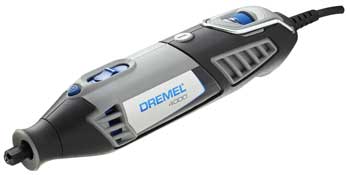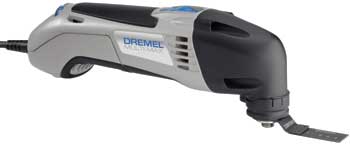
When Alfred Dremel designed the first rotary tool 75 years ago, his intention was to make it versatile. He originally created it for die grinding, but the Moto-Tool quickly became a hit with hobbyists and homeowners because its collet and threaded nosepiece could accept a variety of different accessories and attachments. Its popularity was also due in part to other key design features. Dremel wanted the Moto-Tool to be compact, ergonomic and precise. He felt these characteristics define a what a truly versatile tool system should be.
Through the years, the Dremel Company has carried forward those same principles when designing other new products. “We want to continue to be known as the company that creates versatile tool systems,” says John Hauter, brand manager.
John explained that when the company’s Multi-Max oscillating tool was developed and then launched in 2008, it needed to satisfy the same core tenets as rotary tools. Within the parameters of its intended purpose, the new Multi-Max needed to be compact, versatile, precise and the core tool of a larger system. Considering that the Multi-Max will cut, sand, grind and scrape by simply changing the blade or accessory, it seems those goals are being met. And, according to Hauter, the Multi-Max continues to be an extremely successful tool with consumers.
This fall, Dremel hopes to take its versatile tool systems approach in another direction with a brand-new tool — the Dremel Trio. John says the new Trio is rotary-based, but it’s definitely a hybrid of Dremel’s rotary tool concept. Instead of a straight housing, the new Trio looks more like a miniature jigsaw. The handle can be positioned either perpendicular to the cutting action like a jigsaw or swiveled in line with it, so more in keeping with a rotary tool.
As you can see in the image here, the Trio has a split-style foot that surrounds the cutter for improved support when guiding the tool along. Its collet accepts 3/16-in.-diameter bits, unlike the standard 1/8-in. size for rotary tools. That’s because this new tool develops higher torque for heavier duty cutting operations. And mid-size jobs is where Dremel hopes the tool’s forte will prove itself.
“We’ve designed the Trio to fill a niche between lighter-duty tasks — the applications our rotary tools excel at — and the more demanding jobs you’d normally do with your dedicated router, recip saw or jigsaw.”
The Trio’s name comes from its three intended purposes: to cut, sand or rout. As a cutting tool, the machine’s rotary action will enable it to cut in any direction without the user having to change positions around the workpiece. So, you’ll be able to follow straight or curved lines at will. John says the corded and variable-speed motor spins at up to 20,000 rpm. It will come with a specially designed spiral multipurpose bit that can cut wood, sheet metal, plastics and drywall. A drill-style tip will enable the Trio to make plunge cuts, or you can start it from the edge of a workpiece. Dust collection will be facilitated through a vacuum port in the tool’s base.
Other accessory cutters, including router bits, will be developed for the Trio. The company has already created a circle-cutter attachment for it, which connects to the tool’s foot. Future attachments could be mounted to the same pillar that receives the foot.
Hauter says Dremel regularly conducts focus groups for new tools. So far, response about the Trio has been positive. “When people see it plunging into wood, then plexiglas, then metal and drywall—with one tool and bit doing all of this and doing it well — their response is basically, “Wow!'”
Evidently, the “wow” factor was in full effect two weeks ago at the National Hardware Show in Las Vegas. Dremel’s Trio won a product innovation award there. Although the tool was unveiled at the Hardware Show, Hauter says the the Trio officially launches and will be in stores in September. It will sell for $99.99.
“We think the new Trio is an evolution of sorts over what we’re already doing successfully within the rotary and oscillating tool categories. But, it also clarifies for us what we’re really about: creating tool systems that are compact, versatile, ergonomic and precise. This is what we do really well, and this is what we should be doing.”








